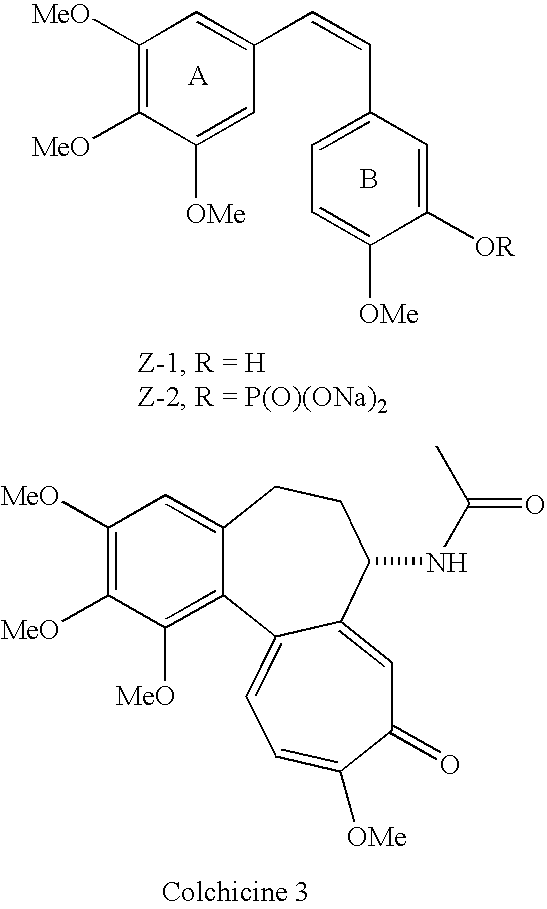Substituted stilbenes and their reactions
a technology of stilbenes and e-1, which is applied in the field of substitution of stilbenes and their reactions, can solve the problems of poor water solubility and destruction of tumour microvessels, and achieve the effects of improving the selectivity of irradiated e-1, good yield and enhancing the activity
- Summary
- Abstract
- Description
- Claims
- Application Information
AI Technical Summary
Benefits of technology
Problems solved by technology
Method used
Image
Examples
example 1
Synthesis of Combretastatins with Alkyl Groups on the Double Bond
Z- and E-1-(3′-t-Butyldimethylsilyloxy-4′-methoxyphenyl)-2-(3″,4″,5″-trimethoxyphenyl)propene, 17a, 17b
[0123]
[0124]To a slurry of 3-t-butyldimethylsilyloxy-4-methoxybenzylphosphonium bromide, 18, (1 g, 1.69 mmol) in THF (10 ml) was added n-butyllithium (1.16 ml of 1.6 M solution, 1.86 mmol) at −15° C. The red anion was stirred for 20 minutes and 3,4,5-trimethoxyacetophenone (355 mg, 1.69 mmol) added. The resultant solution was stirred at room temperature for 1 hour and water (10 ml) carefully added. The aqueous layer was separated and extracted with ether (3×10 ml). The combined organic layers were washed with water (2×10 ml) and brine (10 ml), dried (MgSO4) and concentrated in vacuo.
[0125]Following flash column chromatography (SiO2 petrol:EtOAc 19:1) the Z stilbene, 17a, was isolated as a colourless oil (109 mg, 15%). Rf=0.72 (SiO2 petrol:EtOAc 1:1); δH (300 MHz) 0.20 [6 H, s, (CH3)2], 1.03 [9 H, s, (CH3)3], 2.28 (3 H...
example 2
Synthesis of Combretastatins with Alkyl Groups Replacing the Methoxy Groups on the A Ring
E-2-(3′,4′,5′-trimethylphenyl)-3-(3″-(2′″,3′″,5′″,6′″-tetrafluoropyridoxy)-4″-methoxyphenyl)prop-2-enoic acid, 24
[0137]
[0138]A mixture of 3-(2′,3′,5′,6′-tetrafluoropyridoxy)-4-benzaldehyde 25 (2 g, 6.64 mmol), 3,4,5-trimethylphenylacetic acid 26 (2.37 g, 13.3 mmol) acetic anhydride (6 ml) and triethylamine (3 ml) were heated under reflux for 3 h. After acidification with concentrated hydrochloric acid (9 ml), the solid was filtered off and recrystallised from ethanol to give E-2-(3′,4′,5-trimethyl)-3-(3″-(2′″,3′″,5′″,6′″-tetrafluoropyridoxy)-4″-methoxyphenyl)prop-2-enoic acid 24 as a yellow crystalline solid (700 mg, 1.52 mmol, 23%). m.p. 184–6° C. δH (300 MHz, DMSO) 2.11, (3 H, s, CH3), 2.14 (6 H, s, (CH3)2), 3.83 (3 H, s, OCH3), 6.61 (1 H, d, J=1.5, H-2″), 6.71 (2 H, s, H-2′,6′), 7.13 (1 H, d, J=8.7, H-5″), 7.19 (1 H, dd, J=8.7, 1.5, H-6″), 7.61, (1 H, s, olefinic H), 12.52, (1 H, s OH).
(Z)-1-...
example 3
Synthesis of Combretastatins with a 3,4,5 Trialkoxy Group
Z- and E-1-(3′,4′,5′-triethoxyphenyl)-2-(3″-t-butyldimethylsilyloxy-4″-methoxyphenyl)ethene, 30a, 30b
[0143]To a slurry of 3,4,5-triethoxybenzylphosphonium bromide 29 (2 g, 3.24 mmol) in THF (30 ml) was added n-butyllithium (2.5 ml of 1.6M solution in hexanes, 4 mmol) at −15° C. under argon. The red anion was stirred for 20 min and 3-O-t butyldimethylsilyl-4-methoxybenzaldehyde 6 (0.86 g, 3.24 mmol) added. The resultant solution was stirred for 1 h at room temperature and water (10 ml) was carefully added. The aqueous layer was separated and extracted with ethyl acetate (3×100 ml). The combined organic layers were washed with water (2×100 ml), brine (100 ml), dried (MgSO4) and concentrated in vacuo. Flash column chromatography afforded the cis stilbene 30a as a colourless oil (0.23 g, 15%). Rf=0.65 (petrol:ethyl acetate 9:1); δH (300 MHz) 0.08 (6 H, s, Si(CH3)2), 0.95 (9 H, s, 3×CH3), 1.35 (9 H, m, 3×OCH2CH3), 3.79 (3 H, s, OCH...
PUM
| Property | Measurement | Unit |
|---|---|---|
| Temperature | aaaaa | aaaaa |
| Temperature | aaaaa | aaaaa |
| Molar density | aaaaa | aaaaa |
Abstract
Description
Claims
Application Information
 Login to View More
Login to View More - Generate Ideas
- Intellectual Property
- Life Sciences
- Materials
- Tech Scout
- Unparalleled Data Quality
- Higher Quality Content
- 60% Fewer Hallucinations
Browse by: Latest US Patents, China's latest patents, Technical Efficacy Thesaurus, Application Domain, Technology Topic, Popular Technical Reports.
© 2025 PatSnap. All rights reserved.Legal|Privacy policy|Modern Slavery Act Transparency Statement|Sitemap|About US| Contact US: help@patsnap.com



